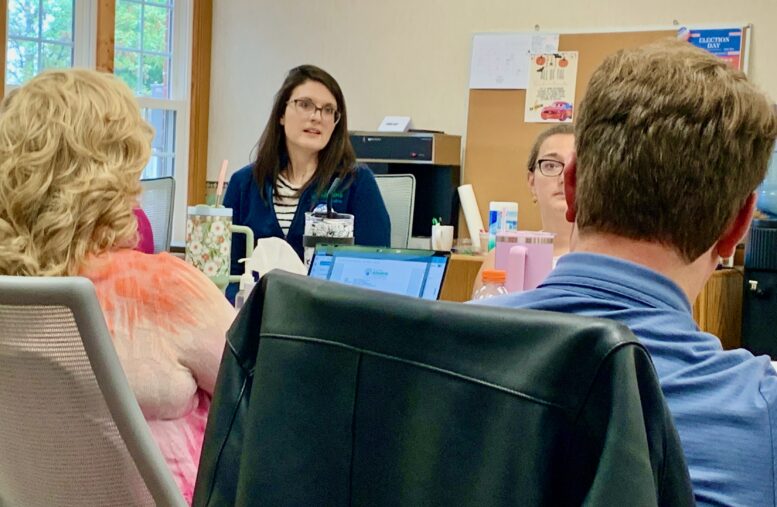By JULIE CARLE
BG Independent News
A change in the application process for state opioid and stimulant response (SOS) grant funding caught the Wood County Alcohol, Drug Addiction and Mental Health Services Board off guard a bit.
This year, instead of the county board overseeing the application, distribution and reporting of SOS funds for all local programs, the Ohio Department of Mental Health and Addiction Services allowed providers to directly apply for the state grants. If approved by the state, the funds will go directly to the agencies rather than through the county board. for substance use disorder programming.
The change means the state grants will go directly to the agencies rather than the county board
The new request for proposal process means the contracts the WCADAMHS approved in June for local providers will have to be amended, Amanda Kern, WCADAMHS executive director, reported at the September board meeting.
“We built the SOS projects into the yearly contracts for most providers,” Kern said. “We will have to go back as we determine what are the requirements for those different programs.”
The NARCAN vending machines and the Addiction Response Collaborative were included in the WCADAMHS grant application, and the other local agencies were informed about the grant opportunity and encouraged to apply, Kern said.
The change could also impact how much of levy dollars will be used to fund substance use prevention and treatment programs.
“We weren’t able to determine whether or not we were going to continue funding everything out of levy dollars, that is $1.4 millions worth of programming that is covered under the SOS grant,” she said.
Because the county board was “removed from the equation,” Kern said “we hope to work with local providers “to make sure we know what’s happening in the community to know if there are any gaps” in services.
The change “was unprecedented and not predicted,” she said. There had been no communication until the Request for Proposals was announced.
The process creates opportunities for providers to expand their programming; however, one of Kern’s concerns is that the state plans to prioritize funding based on overdose rates. Because Wood County has a lower overdose rate due to successful prevention and intervention efforts, the county may not be high on the priority list.
“We really don’t know who in Wood County may have applied,” said board chair Frank McLaughlin “For a board that is supposed to have a hand in planning these services it is an interesting move.”
Homeland Security Grant
The WCADAMHS learned the Department of Homeland Security’s $398,971 two-year grant brings Wood County into the Targeted Violence and Terrorism Prevention Coalition.
The grant focuses on the expansion of threat assessment and management tools. It also covers a position for building relationships with schools, participating on threat assessment and management teams and helping access resources for youth who are identified as high or moderate risk for violence against themselves or others.
The board approved the systems navigation position to assist with the two-year grant.
Wood County is listed as a partner with Harbor College to build a prevention network and to have a symposium at the end of the grant cycle to highlight the best practices for prevention, assessment and intervention from across the country.
Outcomes updates
Dr. Laura Fullenkamp, director of criminal justice compliance, shared some of the updated outcomes reports of the board’s nine service providers:
- Addiction Response Collaborative: The Quick Response Team responded to calls within 72 hours 100% of the time with 97% of the program participants not having any additional overdoses. The Pre-Trial Diversion Program met three of the four outcomes, including a 90% successful completion rate, and 97% of participants were not charged with a new offense after they ended the program. A low response rate for a post-treatment survey was the only outcome that wasn’t met.
- Children’s Resource Center’s mental health programming served 867 youths in the past year. Seventy-eight percent of the youth and families reported symptoms improved between intake and evaluation. Crisis services treated 227 individuals with 92% of the calls responded to within an hour or less. The residential unit, which was below occupancy rates, is reaching out to neighboring counties to let them know about available beds.
- Wood County Educational Service Center successfully reached 4,000 youth for suicide prevention in the schools. Ninety-seven percent reported they knew where to go for mental health crisis help. More than 3,000 youth received substance use prevention programming.
- Harbor’s mental health programs served 3,000 adults and 516 youths last year. Of those, 95% of those served were offered assessments within 10 days. For those individuals coming out of hospitals, 91% were offered assessments within seven days. The employment services program served 181 individuals and helped 128 obtain jobs.
- NAMI Wood County has many programs that had positive outcomes, including the peer education programs such as family-to-family, peer-to-peer, WRAP and NAMI Basics.
- The Cocoon had 123 people in shelter, and 100% were screened for behavioral health issues and attempted to link to treatment services. They worked with 273 individuals in the community-based programs and screened 100% for behavioral health issues.
- Ohio Guidestone’s mental health programming served 660 adults and 251 youth, with 89% reporting improvements in anger and anxiety management and 86% improvement for depression. Their substance use treatment worked with 200 clients and 80% remained in treatment for 90 days and 77% were successfully discharged. Outcomes for some criminal justice programs, primarily those involving engagement, were not met; however, they are looking at some ideas to improve post-release communications.
- Unison’s crisis services have seen increases and progress since opening. The agency is planning a slow rollout of urgent care services; however, the service will be handled from the Main Street office.
- The occupancy rate for the Zepf Center recovery house is being reduced because the existing rate was not realistic, Fullenkamp said. The methadone outpatient services served 68 clients, more than the 35 projected for the year. They had 21 people in the recovery program, all participating in the recovery meetings. The participants averaged 118 days in the program.
Also during the meeting:
• Daniel Lambert resigned from the board since he no longer lives in the county. He has been on the board for six years and previously served in leadership roles as chair and vice chair. “The opportunity to serve with all of you has been an honor,” he said.
• The board approved a resolution to support the $250,000 local match required for the $750,000 grant for Children’s Resource Center’s Capital Project Youth Resiliency Match.
• Jessica Hartman, executive director of NAMI Wood County reminded the board about the AfterBurn event Oct. 4 at the Wood County Junior Fair Building from 4:30-7:30 p.m.
• Laura Stack will present a Youth THC Prevention program on Oct. 7 at 6 p.m. at Penta Career Center. The event is sponsored by the Wood County Educational Service Center, Wood County Addiction Task Force, Wood County Alcohol, Drug Addiction and Mental Health Services, Wood County Prevention Coalition and Children’s Resource Center.
• Kathy Mull, executive director of The Cocoon, announced the agency’s major fundraiser, Dueling Pianos, will be held Oct. 25 from 7 to 11 p.m. at Stone Ridge Golf Club. Registration and information are available here.





